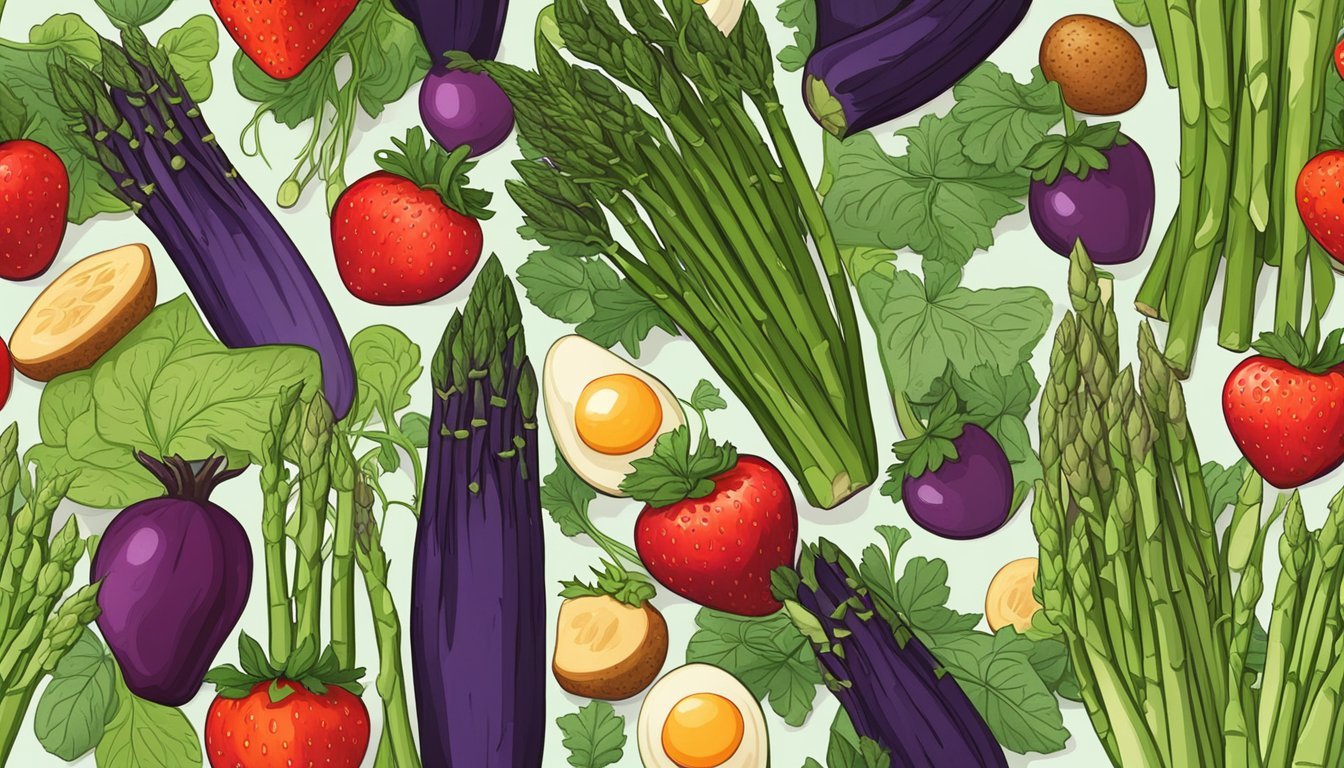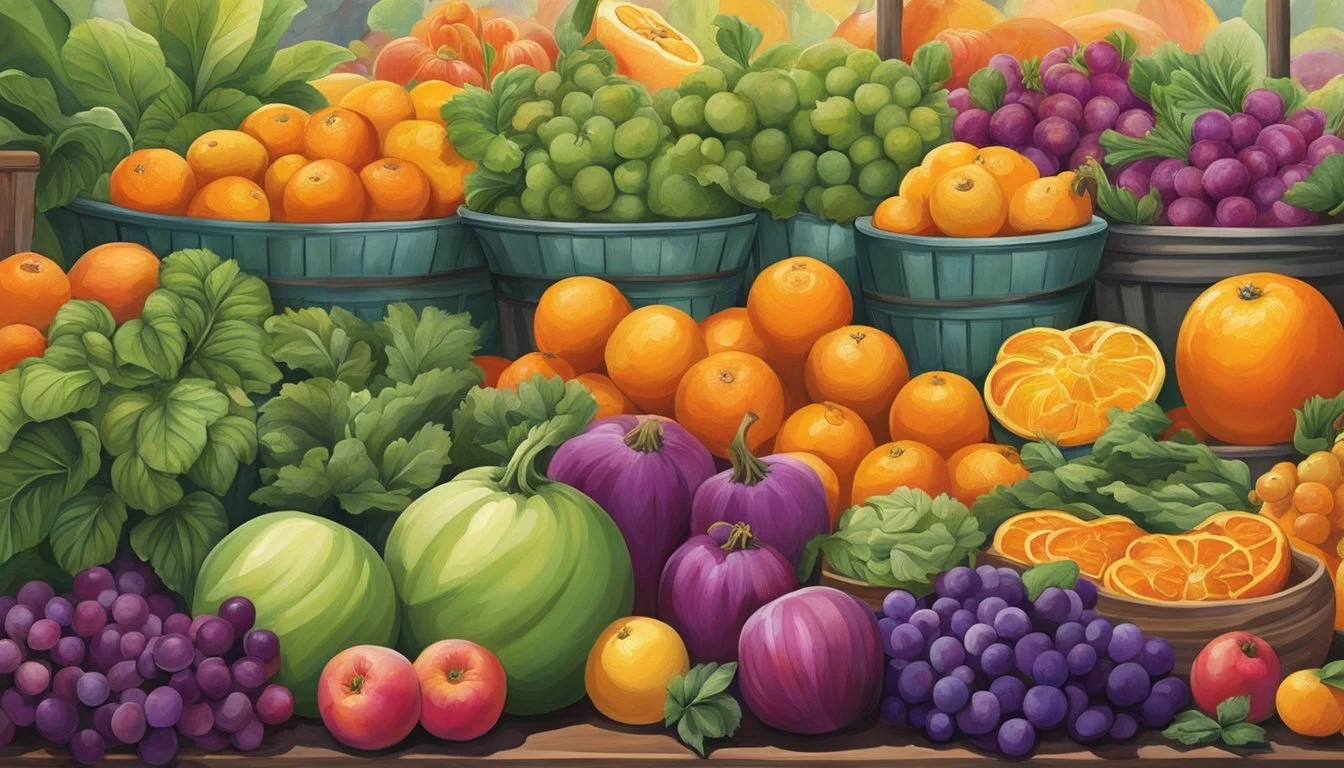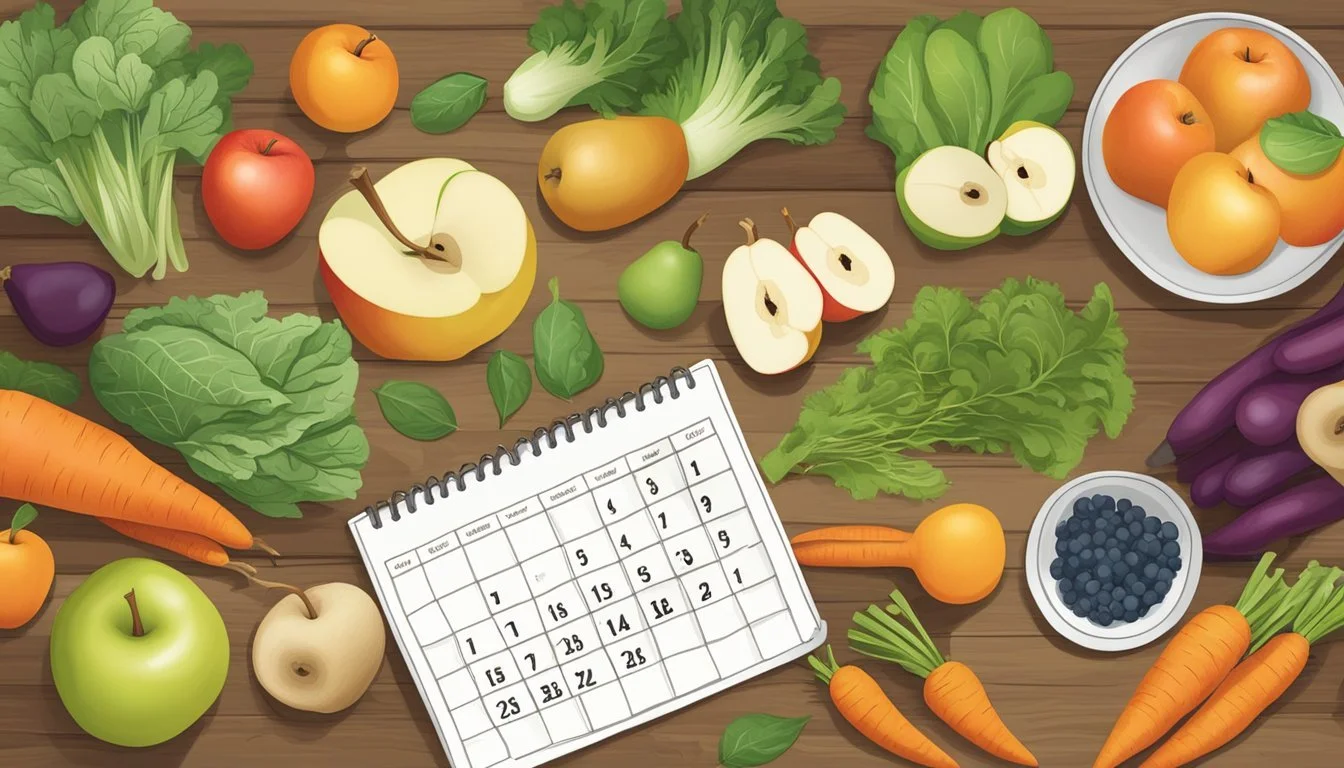Washington Seasonal Fruit & Vegetables in March
Your Guide to Fresh Produce
This Article is Part of our Washington Seasonal Fruit & Veg Calendar
March in Washington heralds the arrival of spring, and with it comes a shift in the state's seasonal produce offerings. As the days grow longer and the soil begins to warm, the agricultural regions across Washington awaken, offering a variety of fruits and vegetables. March is a transitional month, and while winter crops are still available, the first tender shoots of spring produce begin to emerge.
For locals and chefs alike, March offers the last chance to savor winter crops like apples and pears from storage, while the earliest spring vegetables such as leeks, spring onions, and radishes make their appearance in the market. Washington's diverse climates, from the cool coastal areas to the more arid eastern regions, play a significant role in what produce is available during this time of the year.
Those seeking fresh, locally-grown produce in March can expect to find a balance between the tail end of winter's hearty offerings and the initial signs of spring's fresh bounty. Although it's not yet the peak season for most fruits and vegetables, the available produce is celebrated for its contribution to a seasonal diet, emphasizing freshness and regional variety.
Overview of Washington's Seasonal Produce
March Highlights
In March, Washington state transitions from winter's chill to the milder days of spring. Seasonal produce availability starts to widen, reflecting the state's diverse climatic regions. Consumers seeking fresh, local vegetables and fruits will find several options despite the tail end of winter's grip.
Vegetables:
Leeks: These continue from winter, offering a subtle, sweet onion flavor.
Potatoes: Stored from previous harvests and still a staple in March.
Root vegetables also persist from winter, with selections like parsnips and beets. While these may be from storage, they still maintain quality and flavor.
Greens:
Kale: Hardy and nutritious, it thrives in cooler temperatures.
Spinach: Begins to come into season, introducing fresh, tender leaves to the market.
These leafy greens exemplify Washington's ability to produce excellent cool-season crops.
Fruits:
March is not peak fruit season in Washington, but cold storage and controlled atmosphere storage allow apples and pears to remain available. They retain their crispness and sweetness, providing a taste of autumn's bounty well into the spring.
Greenhouses and Storage:
Washington utilizes greenhouses and advanced storage techniques to extend the availability of some produce. Greenhouses begin yielding cucumbers and tomatoes, although in limited quantities. Storage methods prolong the shelf-life of many root vegetables and hard-skinned squash from prior seasons.
Planning and Purchasing:
Residents and chefs looking to plan menus or shopping lists around what's in season can anticipate gradually increasing options, yet should rely on the last of winter's produce and stored goods. As spring progresses, the diversity and volume of seasonal produce will expand markedly.
Seasonal Fruits in March
In Washington state, the month of March provides limited availability of local fruits due to the region's climate. However, attentive consumers can still find a variety of fruits that are in season. Apples, stored from fall harvests, are commonly available and maintain their quality. Likewise, pears exhibit similar resilience in storage, offering freshness and flavor.
Citrus fruits, although not grown in Washington, are at their peak in other parts of the United States and are readily accessible in Washington markets. Within this category, lemons stand out with their bright color and tartness, enhancing a multitude of culinary applications from dressings to desserts.
List of Seasonal Fruits in March:
Apples: Still crisp with a variety of types such as Gala, Fuji, and Granny Smith.
Pears: Soft and sweet, varieties like Anjou and Bosc are often found.
Citrus: Includes oranges and grapefruits; imported lemons are especially good for baking and beverages.
Pineapple: While not native, they are typically harvested in tropical climates and are in good supply.
Consumers should note that while some fruits like pineapples are not indigenous to Washington, they are often available due to imports from regions where they are currently in season. They are a juicy and sweet option for those seeking a tropical flavor.
In summary, the availability of seasonal fruits in Washington during March includes a mixture of stored local produce and imported goods, offering a range of flavors from the crispness of apples to the zesty tang of citrus fruits.
Seasonal Vegetables in March
March in Washington brings a variety of fresh produce, with certain vegetables reaching their peak. Consumers can expect to find an array of leafy greens and herbs, along with fresh cruciferous, root vegetables, and alliums, which add vibrant flavors and nutrients to the springtime table.
Leafy Greens and Herbs
During the month of March, leafy greens like spinach, kale, and arugula (how long does arugula last?) are in season. Lettuce varieties also flourish, providing the base for nutritious salads. Herbs such as parsley, cilantro, rosemary, sage, and thyme are readily available, ideal for adding fresh and aromatic touches to dishes.
Cruciferous Vegetables
The cruciferous family, known for its health benefits, showcases cabbage, broccoli, and cauliflower in March. Even Brussels sprouts (how long do brussels sprouts last?) may still be found, as they linger from their winter peak.
Root Vegetables
Robust root vegetables continue to thrive in early spring. Shoppers will find radishes, turnips, and parsnips. Carrots and beets also make a colorful addition to the March vegetable roster, bringing sweetness and earthiness to meals.
Alliums
Alliums, which are foundational for their depth of flavor, include leeks, onions, garlic, and shallots. These are essential for building the base of many aromatic dishes and are widely used in seasonal cooking.
Other Vegetables
March also offers a diverse selection of other vegetables. Asparagus begins its short but highly anticipated season, while artichokes(What wine goes well with artichokes?) make a bold entrance. Fresh peas start to appear and mushrooms, though not a vegetable by classification, are commonly grouped with produce and continue to be available.
Cooking Tips For Seasonal Produce
In March, Washington state offers an array of seasonal vegetables such as brassicas and root vegetables, which can be used in a wide range of culinary applications. For enthusiasts looking to maximize the potential of March's bounty, confidence and clarity in technique are key.
Roasting brassicas, like Brussels sprouts or cabbage, brings out a delightful caramelization which can serve as a robust side dish. To achieve perfection, they should be cut uniformly and tossed with a coat of olive oil, salt, and pepper, ensuring each piece is evenly seasoned. Roasting at a high temperature, around 425°F, until they reach a golden-brown hue offers an enticing balance of crispy edges and tender centers.
For root vegetables, such as beets and carrots, steaming preserves their natural flavors and nutritional value. One may integrate these vegetables into a pasta (how long does pasta last?) to add both color and a gentle sweetness, complementing the savoriness of the dish. They should be cut into bite-sized pieces and steamed just until fork-tender before tossing them with your pasta and preferred sauce.
Assembling a salad is another avenue to showcase the fresh taste of March greens. Utilizing ingredients like arugula (how long does arugula last?) paired with thinly sliced root vegetables provides a mix of peppery and earthy notes. A light vinaigrette can elevate the freshness, while allowing the inherent flavors of the produce to shine through.
Furthermore, integrating these vegetables into recipes needs a thoughtful approach to seasoning and method. One must be aware that each vegetable's unique characteristics contribute to the overall flavor profile of a dish, whether it's used as a stand-alone component or is combined with other ingredients.
Benefits of Eating Seasonally
Eating seasonally provides significant advantages, particularly when it comes to fruits and vegetables in Washington during March. The practice of consuming produce that is harvested at the right time of year supports nutrition and peak freshness.
Flavor: Seasonal fruits and vegetables from Washington are often packed with flavor. Harvested at the optimum time, these items deliver a natural and robust taste.
Nutritional Value: Seasonal produce is at its nutritional peak, meaning it contains more vitamins, minerals, and antioxidants. This is because crops harvested during their appropriate seasons require less human intervention and can grow without excessive reliance on additives.
In terms of health benefits, eating raw and through cooking seasonal fruits and vegetables can contribute to a healthier diet. They tend to have a higher nutrient profile compared to out-of-season produce that may have traveled long distances and degraded in quality.
Seasonal Eating Benefits Enhanced Flavor Higher Nutritional Value Supports Local Agriculture Potentially Lower Cost
Furthermore, seasonal eating supports local agriculture, which in turn helps to build community and sustains the local economy. By choosing seasonal items, consumers often experience a fresher product due to the reduced time between harvest and consumption.
Lastly, there is often a cost benefit to seasonal eating. When produce is abundant, prices may be lower, making fruits and vegetables more accessible and affordable during their natural growing season.
Where to Find Seasonal Produce
In Washington, March heralds the transition from winter to spring, but the availability of local produce remains tied to the tail end of cold weather crops. Consumers seeking fresh, seasonal produce can find a variety of vegetables and a limited selection of fruits at this time of year.
Farmers' Markets: These are excellent sources for seasonal produce. They bring fresh, local, and often organic produce directly from farmers to consumers. Farmers' markets in Washington operate year-round or have specific opening dates in early spring. Shoppers can find a list of markets and their operational hours at the Washington State Farmers Market Association website.
Local Farms: Many Washington farms offer community-supported agriculture (CSA) programs. Participants receive a regular (usually weekly) delivery or pickup of fresh produce directly from the farms. CSA shares typically include leafy greens, root vegetables, and other cool-season crops during March.
Co-ops and Local Grocery Stores: These establishments often stock produce sourced from local farms. Their selection can vary, reflecting what is currently being harvested, and can offer an alternative when farmers' markets are not in session.
Remember, selections will be limited compared to the bountiful summer months. Early spring offerings might include hardy greens, such as kale and collard greens, and overwintered root vegetables like beets and carrots. Although fruit options are sparse, some stores might still carry storage apples and pears from the previous fall. For the most up-to-date information, one should reach out to local farmers, markets, and stores directly or through their online platforms.
Storing and Preserving Fresh Produce
March in Washington brings a variety of fresh produce, and proper storage and preservation methods are key to extending the life of these seasonal fruits and vegetables. They should be aware of the distinct requirements for different types of produce to maintain freshness and minimize waste.
Root Vegetables such as carrots can be stored in a cool, dark place or in the crisper drawer of a refrigerator. It's advisable to remove any green tops to prevent moisture loss and store them in a plastic bag with holes for air circulation.
Leafy Greens like chard and spinach benefit from being wrapped in a damp paper towel and placed in a storage bag in the refrigerator. This method keeps them hydrated while preventing excess moisture, which could lead to spoilage.
Apples, prevalent in Washington, should be stored separately in a cool place. They emit ethylene gas which can accelerate the ripening of other produce.
Herbs are best preserved by snipping the ends and placing them upright in a jar with water, covered loosely with a plastic bag, and refrigerated.
To preserve produce beyond its fresh state, they might consider:
Canning fruits with high acid content or making preserves.
Blanching and freezing vegetables, which helps maintain nutritional value, color, and flavor.
Drying herbs and some fruits in a dehydrator or a low-temperature oven.
Understanding and applying these storage and preservation techniques ensures that Washington's seasonal fruits and vegetables can be enjoyed to their fullest potential.
March Seasonal Produce Calendar
In March, residents of Washington are on the cusp of spring, a pivotal time for local produce. Farmers' markets begin to showcase the early bounty of the season, with a range of vegetables and a few fruits becoming available.
Vegetables:
Greens: Arugula, kale, and spinach are readily available, offering fresh leaves perfect for hearty salads.
Root Vegetables: While some, like beets and carrots, are holdovers from winter storage, they remain crisp and sweet.
Brassicas: Broccoli and cabbages are in supply, lending themselves to a variety of dishes, from stir-fries to slaws.
Fruits:
While fruit selections are still sparse, apples from the previous autumn's harvest can still be found, alongside stored pears.
Herbs:
Spring herbs like parsley and chervil start to emerge, adding freshness to dishes.
Other Notables:
Leeks and shallots offer depth to the spring palate, ideal for soups and braises.
In employing this monthly guide, consumers are encouraged to partake in the freshest produce that March in Washington has to offer, embracing the seasonal rhythm and supporting local agriculture.






